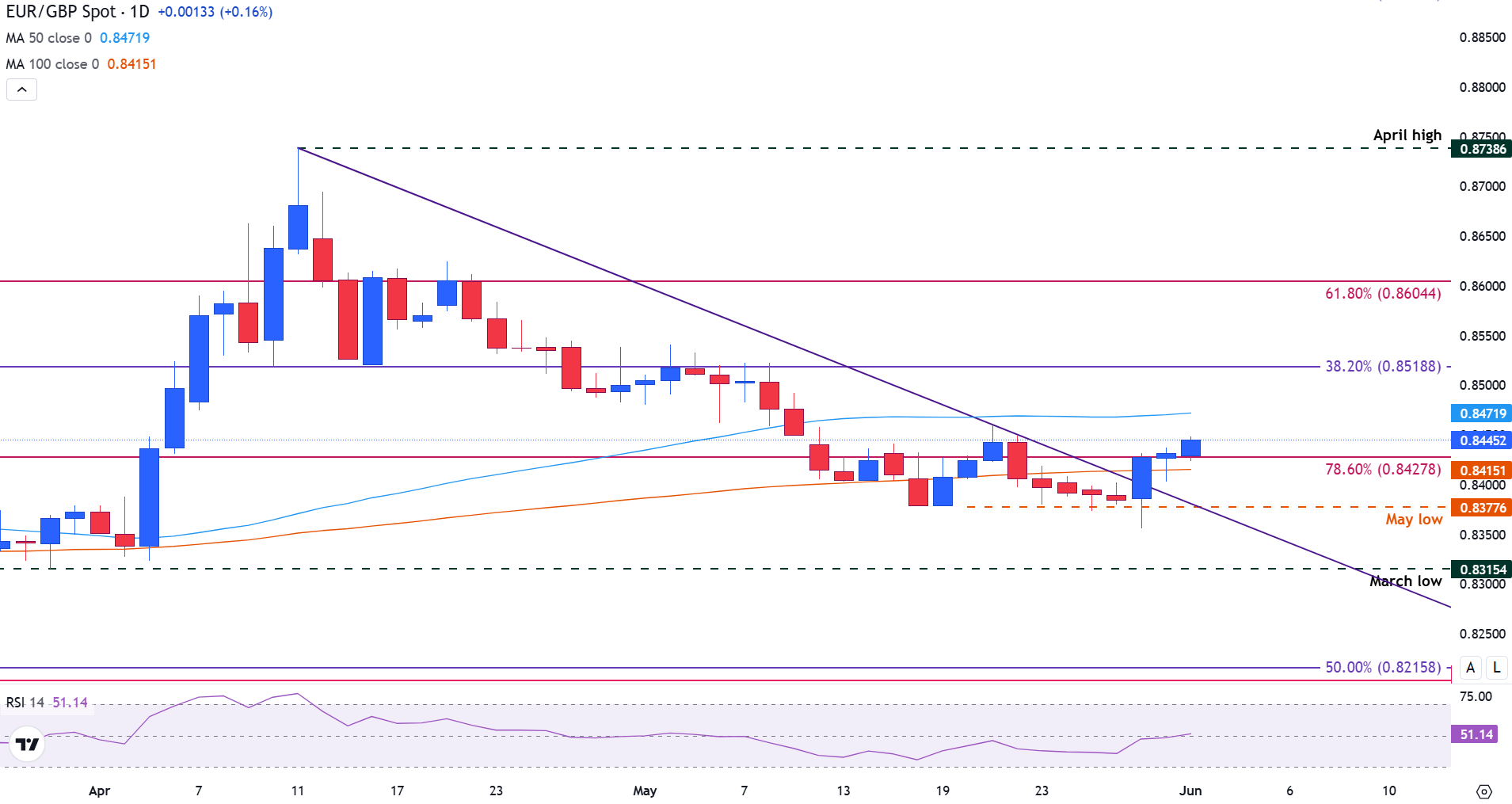EUR/GBP steadies as pair holds above key technical resistance
- EUR/GBP stabilizes on hopes of positive developments and talks in the Eurozone
- Europe’s Manufacturing data shows slight signs of improvement, lifting the Euro.
- EUR/GBP moves toward the key 78.6% Fibonacci resistance level.
The Euro (EUR) is consolidating against the Pound Sterling (GBP) on Monday, with markets focusing on key economic data and geopolitical developments.
At the time of writing, EUR/GBP is trading above the 100-day Simple Moving Average (SMA) and is firmly supported above the key psychological level of 0.8400.
In the Eurozone, the manufacturing sector showed signs of recovery on Monday, with the HCOB Eurozone Manufacturing Purchasing Managers' Index (PMI) rising to 49.4 in May from 49.0 in April, marking a 33-month high. While markets interpreted the data as a potential sign that the sector may be moving out of the previous downturn, it remains below the 50.0 growth threshold, indicating that expansion has not yet been achieved.
The UK manufacturing sector continues to face challenges, with the S&P Global UK Manufacturing Purchasing Managers' Index (PMI) rising slightly to 46.4 in May from 45.4 in April. While this marks the highest reading since February, it remains below the neutral 50.0 threshold, indicating that the contraction is ongoing.
Adding to the complexity of the situation, the upcoming meeting between Germany's new Chancellor, Friedrich Merz, and US President Donald Trump could further influence EUR/GBP sentiment. Discussions on transatlantic relations, trade policies, and the Ukraine conflict may impact market expectations for the Euro’s economic stability and geopolitical alignment. Any shifts in US-European relations could lead to changes in investor perception of the Eurozone’s stability, thus influencing the EUR/GBP pair, especially given the current economic struggles in the UK.
EUR/GBP finds support above the 100-day Simple Moving Average
EUR/GBP continues to trade above the 100-day Simple Moving Average (SMA) at 0.8415 and above the 78.6% Fibonacci retracement level of the March-September 2022 move near 0.8428. The 50-day SMA now serves as resistance at 0.8472; a break of this level could open the door for a bullish continuation toward the 0.8500 psychological level.
The Relative Strength Index (RSI) is at 49, moving closer toward the neutral zone at 50.
For bears to regain confidence, a move below the 100-day SMA and 0.8400 could lead to a retest of the May low at 0.8378 and a potential return towards the prior trendline resistance, now support at 0.8350.
EUR/GBP daily chart

,
Euro FAQs
The Euro is the currency for the 19 European Union countries that belong to the Eurozone. It is the second most heavily traded currency in the world behind the US Dollar. In 2022, it accounted for 31% of all foreign exchange transactions, with an average daily turnover of over $2.2 trillion a day. EUR/USD is the most heavily traded currency pair in the world, accounting for an estimated 30% off all transactions, followed by EUR/JPY (4%), EUR/GBP (3%) and EUR/AUD (2%).
The European Central Bank (ECB) in Frankfurt, Germany, is the reserve bank for the Eurozone. The ECB sets interest rates and manages monetary policy. The ECB’s primary mandate is to maintain price stability, which means either controlling inflation or stimulating growth. Its primary tool is the raising or lowering of interest rates. Relatively high interest rates – or the expectation of higher rates – will usually benefit the Euro and vice versa. The ECB Governing Council makes monetary policy decisions at meetings held eight times a year. Decisions are made by heads of the Eurozone national banks and six permanent members, including the President of the ECB, Christine Lagarde.
Eurozone inflation data, measured by the Harmonized Index of Consumer Prices (HICP), is an important econometric for the Euro. If inflation rises more than expected, especially if above the ECB’s 2% target, it obliges the ECB to raise interest rates to bring it back under control. Relatively high interest rates compared to its counterparts will usually benefit the Euro, as it makes the region more attractive as a place for global investors to park their money.
Data releases gauge the health of the economy and can impact on the Euro. Indicators such as GDP, Manufacturing and Services PMIs, employment, and consumer sentiment surveys can all influence the direction of the single currency. A strong economy is good for the Euro. Not only does it attract more foreign investment but it may encourage the ECB to put up interest rates, which will directly strengthen the Euro. Otherwise, if economic data is weak, the Euro is likely to fall. Economic data for the four largest economies in the euro area (Germany, France, Italy and Spain) are especially significant, as they account for 75% of the Eurozone’s economy.
Another significant data release for the Euro is the Trade Balance. This indicator measures the difference between what a country earns from its exports and what it spends on imports over a given period. If a country produces highly sought after exports then its currency will gain in value purely from the extra demand created from foreign buyers seeking to purchase these goods. Therefore, a positive net Trade Balance strengthens a currency and vice versa for a negative balance.

